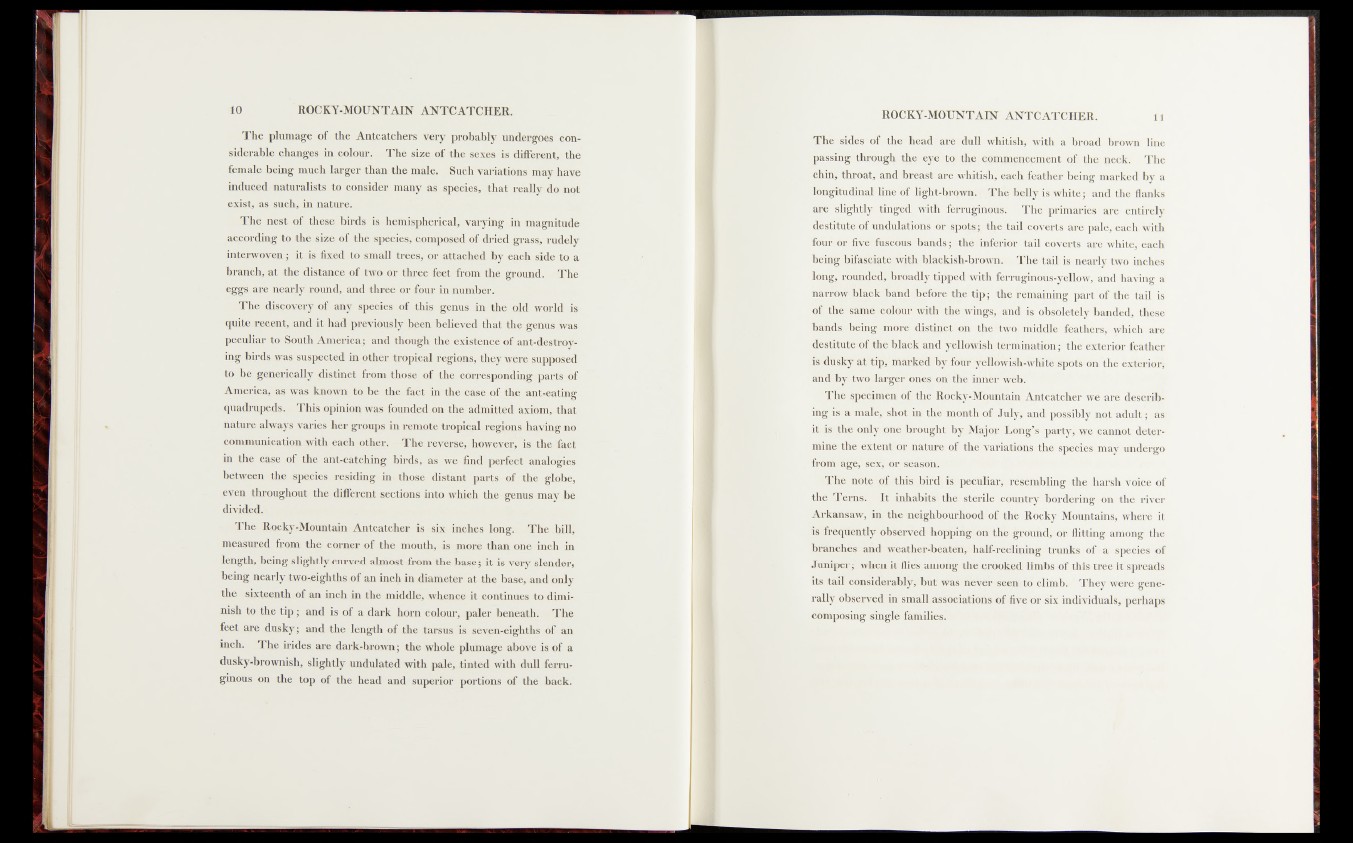
The plumage of the Antcatchers very probably undergoes considerable
changes in colour. The size of the sexes is different, the
female being much larger than the male. Such variations may have
induced natui*alists to consider many as species, that really do not
exist, as such, in nature.
The nest of these birds is hemispherical, varying in magnitude
according to the size of the species, composed of dried, grass, rudely
interwoven; it is fixed to small trees, or attached by each side to a
branch, at the distance of two or three feet from the ground. The
eggs are nearly round, and three or four in number.
The discovery of any species of this genus in the old world is
quite recent, and. it had previously hpen believed that the-genus was
peculiar<tQ 'South America; and though fi^exisfence of ant-destroy-
ing birds was suspected in-other tropical regions, they were supposed
to be generically distinct from those of -jh e corresponding parts of
America, as was known to be |he fact in the case of the ant-eating
quadrupeds. This opinion was founded on the admitted ax&Wi that
nature always varies her groups in remote tropical regipns having no
communication with eaeh other, - The reverse,^hpjvevef,' is the fact
in the case o f the ant-catching birds, as we find perfect analogies
between the species residing in those distant parts off ih‘e.:glob,e,
.even throughout the different sections into which the genus may he
divided^’:.
The RoekyrMountam Antoatcher is six inches long. The -bill,
measured from the corner of the mouth, is more than one inch in
length, being slightly curved almost from the base; it is very slender,
being nearly two-eighths of an inch in diameter at the base, and only
the sixteenth of an inch in the middle, whence it continues to diminish
to the tip ; and is of a dark horn colour, paler beneath. The
feet are dusky; and the length of the tarsus is seven-eighths of an
inch- The irides are .dark-brown; the whole plumage above is of a
dusky-brownish, slightly undnlated with pale, tinted with dull ferruginous
on the top of the head and superior portions of the hack.
11
The sides of the head'.are dull whitish, with a broad brown line
passing through tfye commpnepment qf the neck. The
chin, throat, and breast are whitish’^ 4 c h feather being marked by a
longitudinal line of lightTljrqwn.|^|ii^ belly is white; and the flanks
are slightly tinged with ffi’KmfgKShis. The primaries are entirely
fmstitute of uii(liLl.itnt»yi^-*f?r- spots; the tsiil coverts are pale, each with
four (»r.fiyn^useHijsjVbaiids; the .inferior tail Iji^Efcs are white, each
being hifaseiate with blackish-brown, tail is nearly two inches
long. tipped with ferru^n&^yellow, and having a
narrow black ban|l®ef6re the tip: « remaining part of the tail is
of llffflrar with the wmgs^antfeis obsoletely banded, these
bands. beingV.m^J distinct p.n tjie&t^q. qxLsfflle - feathers, which are
destitute of the black’arid yellowish termination $ the eXSeTiqr feather
is'dusky at tip, marked by sfotir'^eHhMsh-whithispofetdhtoef^xteriori
arid by tw^lWgCr^ones o®ine^iimcr web.
The-specimen of the Rocky-J)®utarii Antcatcher we a rp ’describ-
ing is hlup|&?abD9$)Ui iheBw^feioiqp^ly. and possibly not adult; as
iti-.is,yhe only pne brpughtsby Major Long’s party, we^annoy determine
the ^^®.%;or.nature of the variations the species may undergo
from age, sex; t&O&easoh.
The note-crf this birff is-peculiar,..rpsembling the harsh uvice’-of
|Mr.Terns. It inhabits** th e sterile country fborfferirig on the river
Arkansaw, in ihe neighbourhood of the Rocky .Mountains, whore it
is frequently observed hopping on the ground, or flitting among the
branches and weather-beaten,, half-reclining trunks of'-a species pf
Juniper; when it flies among^©tcfeookbd limbs of this tree it spreads
its tail considerably^ but was-never seen t© climb. They weTe generally
observed in small associations of five or six individuals, perhaps
composing single families.*^